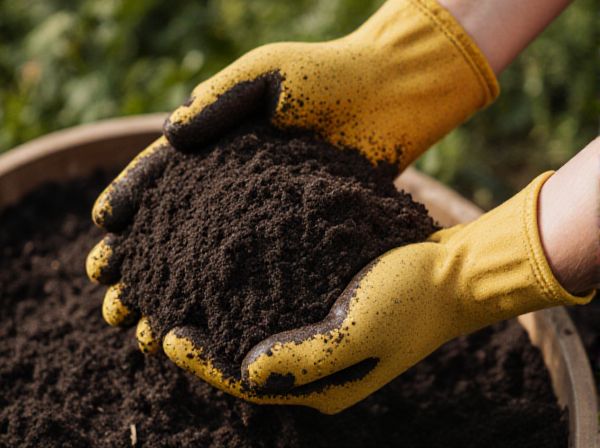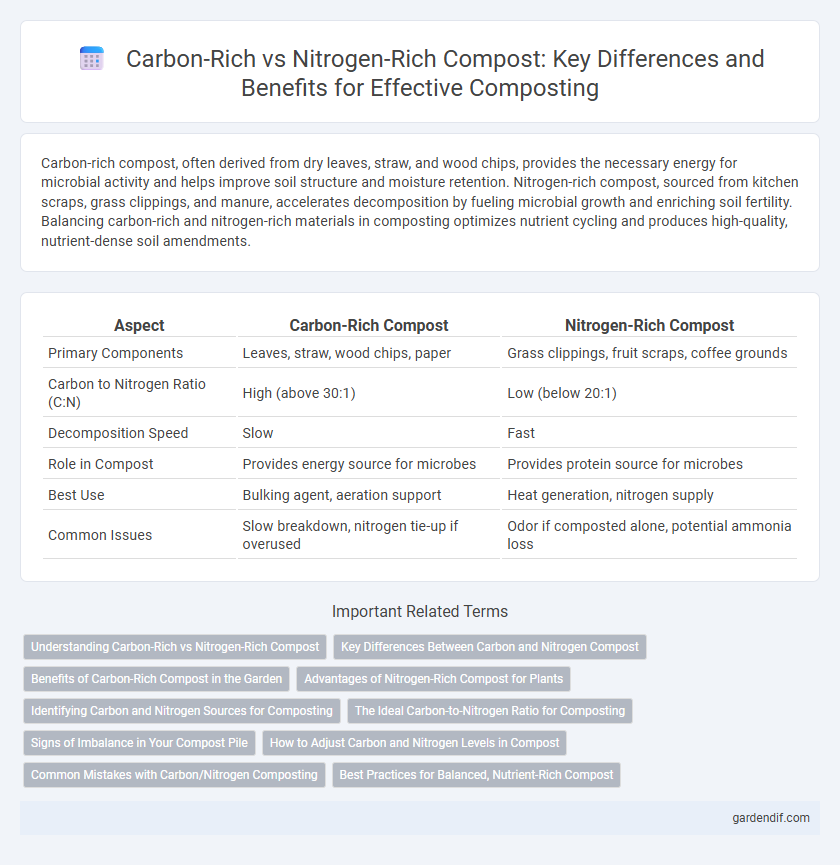
Carbon-rich compost vs Nitrogen-rich compost Illustration
Carbon-rich compost, often derived from dry leaves, straw, and wood chips, provides the necessary energy for microbial activity and helps improve soil structure and moisture retention. Nitrogen-rich compost, sourced from kitchen scraps, grass clippings, and manure, accelerates decomposition by fueling microbial growth and enriching soil fertility. Balancing carbon-rich and nitrogen-rich materials in composting optimizes nutrient cycling and produces high-quality, nutrient-dense soil amendments.
Table of Comparison
| Aspect | Carbon-Rich Compost | Nitrogen-Rich Compost |
|---|---|---|
| Primary Components | Leaves, straw, wood chips, paper | Grass clippings, fruit scraps, coffee grounds |
| Carbon to Nitrogen Ratio (C:N) | High (above 30:1) | Low (below 20:1) |
| Decomposition Speed | Slow | Fast |
| Role in Compost | Provides energy source for microbes | Provides protein source for microbes |
| Best Use | Bulking agent, aeration support | Heat generation, nitrogen supply |
| Common Issues | Slow breakdown, nitrogen tie-up if overused | Odor if composted alone, potential ammonia loss |
Understanding Carbon-Rich vs Nitrogen-Rich Compost
Carbon-rich compost, often derived from dry leaves, straw, and wood chips, contains high levels of carbon necessary for providing energy to soil microbes and improving soil structure. Nitrogen-rich compost, sourced from fresh grass clippings, kitchen scraps, and manure, supplies essential nitrogen that accelerates microbial activity and boosts nutrient availability for plants. Balancing carbon-rich and nitrogen-rich materials optimizes composting efficiency, promoting rapid decomposition and producing nutrient-dense humus for healthy soil ecosystems.
Key Differences Between Carbon and Nitrogen Compost
Carbon-rich compost primarily consists of brown materials such as dry leaves, straw, and wood chips, which provide energy for microorganisms and improve soil structure by increasing aeration and water retention. Nitrogen-rich compost contains green materials like grass clippings, vegetable scraps, and coffee grounds that boost microbial activity and accelerate the decomposition process by supplying essential proteins. Balancing carbon and nitrogen in compost ensures efficient breakdown, resulting in nutrient-rich humus that supports healthy plant growth.
Benefits of Carbon-Rich Compost in the Garden
Carbon-rich compost improves soil structure by increasing aeration and moisture retention, which supports healthy root development in garden plants. It helps balance nitrogen levels, reducing the risk of nutrient burn and promoting slow, steady nutrient release for sustained plant growth. Enhanced microbial activity from carbon-rich compost boosts soil fertility and suppresses plant diseases, leading to a more resilient garden ecosystem.
Advantages of Nitrogen-Rich Compost for Plants
Nitrogen-rich compost accelerates microbial activity and nutrient cycling, enhancing soil fertility and promoting vigorous plant growth. Its high nitrogen content supports essential processes like protein synthesis and chlorophyll production, leading to healthier, greener foliage. This type of compost improves soil structure by increasing organic matter, enabling better water retention and root development for optimal plant health.
Identifying Carbon and Nitrogen Sources for Composting
Identifying carbon sources such as dry leaves, straw, and shredded paper is crucial for balanced composting, as they provide the necessary bulk and energy for microbial activity. Nitrogen sources include green grass clippings, vegetable scraps, and coffee grounds, which supply essential proteins and enzymes that accelerate decomposition. Properly mixing carbon-rich materials with nitrogen-rich components maintains the optimal carbon-to-nitrogen (C:N) ratio, typically around 30:1, to enhance microbial efficiency and produce nutrient-rich compost.
The Ideal Carbon-to-Nitrogen Ratio for Composting
The ideal carbon-to-nitrogen (C:N) ratio for composting is typically around 30:1, balancing carbon-rich materials like dry leaves and straw with nitrogen-rich materials such as grass clippings and kitchen scraps. Maintaining this ratio promotes efficient microbial activity, accelerating decomposition and minimizing odors. Deviations from this balance can slow the composting process or cause unpleasant smells due to excess nitrogen or limited microbial energy from insufficient carbon.
Signs of Imbalance in Your Compost Pile
A compost pile showing a strong ammonia odor or excessive heat often signals nitrogen-rich imbalance, while slow decomposition and dry, brown materials indicate a carbon-rich excess. Wilting plant matter and minimal microbial activity also suggest too much carbon compared to nitrogen. Maintaining a balanced carbon-to-nitrogen ratio between 25:1 and 30:1 ensures optimal microbial function and efficient composting.
How to Adjust Carbon and Nitrogen Levels in Compost
Balancing carbon and nitrogen levels in compost is essential for efficient decomposition and rich soil amendment. To adjust carbon content, add dry, brown materials such as leaves, straw, or cardboard, while increasing nitrogen requires fresh, green materials like grass clippings, kitchen scraps, or manure. Monitoring the ideal carbon-to-nitrogen ratio of approximately 30:1 facilitates microbial activity, accelerates composting, and prevents odor issues.
Common Mistakes with Carbon/Nitrogen Composting
Common mistakes in carbon/nitrogen composting include imbalanced ratios that hinder decomposition, such as using too much carbon-rich material like dry leaves without enough nitrogen-rich greens like grass clippings. Overlooking the ideal carbon-to-nitrogen ratio of 25-30:1 can slow breakdown or cause unpleasant odors due to excess nitrogen. Ignoring proper mixing and moisture levels further disrupts microbial activity needed for efficient composting.
Best Practices for Balanced, Nutrient-Rich Compost
Carbon-rich compost materials, often referred to as "browns," include dried leaves, straw, and wood chips that provide essential energy for microbial activity. Nitrogen-rich compost, or "greens," such as food scraps, grass clippings, and coffee grounds, supply the proteins necessary for microbial growth and efficient decomposition. Best practices for balanced, nutrient-rich compost emphasize maintaining an optimal carbon-to-nitrogen ratio of approximately 30:1, ensuring proper aeration and moisture levels to accelerate organic matter breakdown and produce high-quality soil amendments.
Carbon-rich compost vs Nitrogen-rich compost Infographic

 gardendif.com
gardendif.com